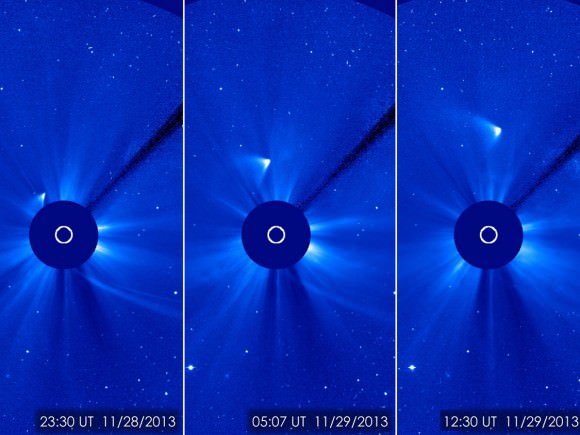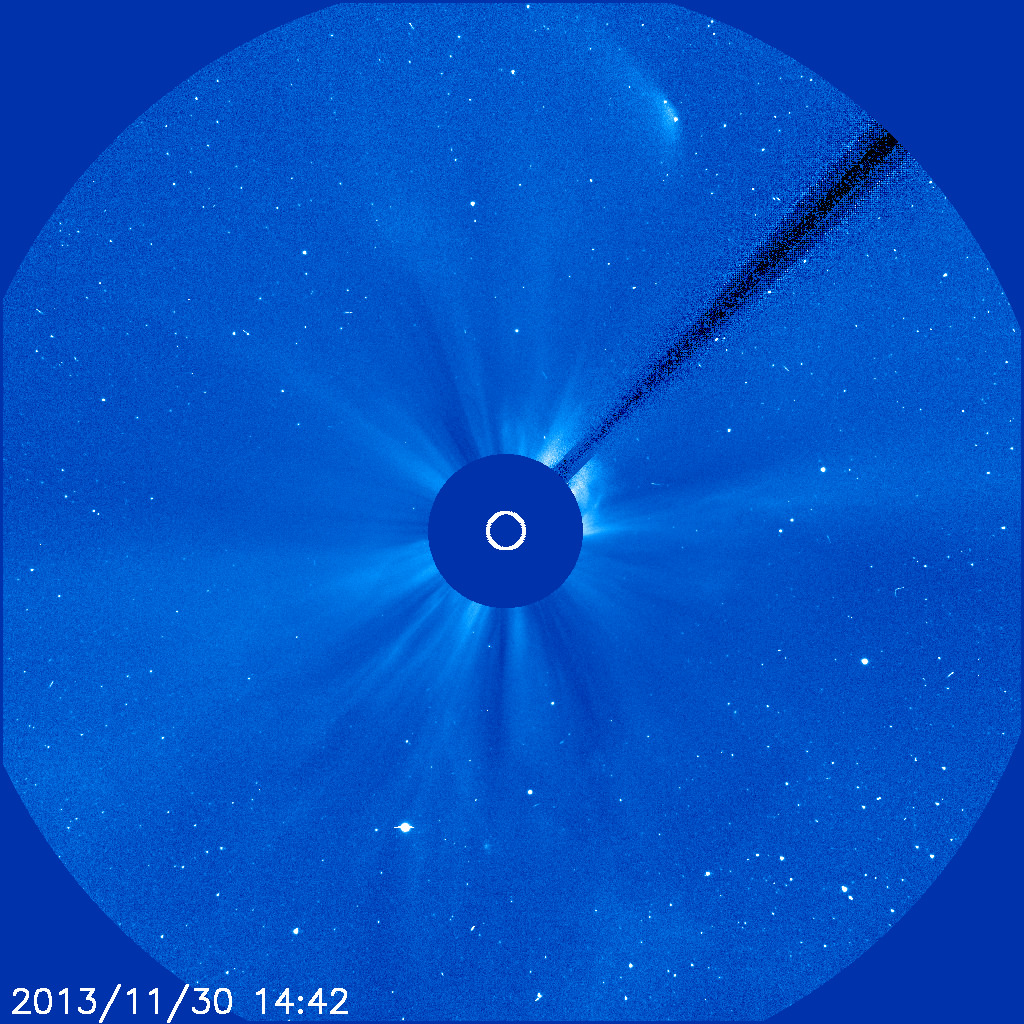A brief morning update (EST) from Karl Battams, who studies sungrazing comets at the Naval Research Laboratory, confirms social media reports that Comet C/2012 S1 ISON appears to be getting fainter in images from the Solar and Heliospheric Observatory (SOHO). (To compare, you can see older images below the jump.)
“Comet #ISON really is fading fast and I no longer see any sign of a “central condensation” (i.e. no obvious indication of a nucleus…),” Battams wrote on Twitter. “I *do* think that something emerged from the Sun, but probably a v.small nucleus or “rubble pile”, and I fear that may have now dissolved.”
This comet, however, has defied predictions over and over again. We’ll keep you posted as to its progress.
Astronomers wrote off Comet ISON on Thursday (Nov. 28) shortly after it rounded the sun, but it brightened considerably afterwards and researchers said it’s possible a small nucleus did survive the close encounter. Battams previously noted ISON’s behavior is much different than the other 2,000 or so sungrazers he’s observed.
The comet was discovered Sept. 21, 2012 by Artyom Novichonok and Vitali Nevski while conducting the International Scientific Optical Network (ISON) survey and has been the subject of intense speculation about its brightness prospects since.



“ISON will be brighter than the full moon” instead we get Kouhoutek Release 2.0
That’s life
At least it got less hype than Halley’s Comet, a.k.a. The Greatest Astronomical Scam of the 20th Century. This is why astronomers are not trusted these days.
The hype has nothing to do with the astronomers – blame the bloody media!
I’ll buy that, but I sure saw a good number of astronomers happy to have their name in the paper who weren’t doing anything to dispel the myth. Might wanna get quicker on that press-release because the disappointed public is going to come looking for YOU, and tell your Congressmen/Parliament that you’re over-funded.
Astronomers were saying that it COULD be that bright but it was only a wait-and-see… That’s why they’ve all been waiting for it to pass behind and then emerge from the far side of the Sun with baited breath. JOURNALISTS ONLY (NON-SPACE ONES… hehehe) said, “ISON WILL be brighter than the full moon.” That verbiage sells ink and page hits.
A Poem for Comet ISON
Comet Ison
Where’d you go?
Cause no one here
Seems to know.
Will I see you
Late at night?
From your death
Defying flight.
Frozen fireworks,
Rocks and ice.
To re-emerge
That would be nice
The sun is hot,
So now you know.
Around the sun
You should not go.
A great piece of creativity
Thank’s
nice poem dude…am sure comet ISON will be proud of you.. 🙂
I am very much thanks to this website for proving the nice technology and for the information is also very great I am very much satisfied to this technology. You are very like this information and I am defiantly shore about that.
12.01.13 Up @ 4 and out the door… stars to the horizon, what little of it I can see here in the canyon. Scanning my sky turned up Comet #48 for me! YIPPEE! and YES! Look out numero 50.. Here I come! Comet Lovejoy! is aptly named…Nice…it was next to a constellation star in N. Bootes, and was an _easy_ object in my 7X35 binocs! Looked as bright as M31 er so.. But isn’t it funny how even a little bit of dawn or dusk light can wipe the seeing a comet? They are definitely a ‘trick’ and a ‘treat’!
This is mere speculation on my part: Could the possible reason that it was so variable both going towards and away from perihelion be its lower density by comparison to the more robust comets?
Using the admittedly simplistic snowball analogy, I consider the snowballs of my youth. Harder icy masses from older snow could raise welts, but fluffy new fallen powder-made balls with much more air and less cohesion would merely dissipate against exposed skin amusingly.
But the problem is that on a comet the gravitational field is almost non-existent so the pressure of the snow is minimal.
Also this comet never came here before so it is not a situation where a top layer melted last time.
Never mind Ison, looks like ice off